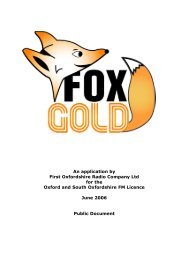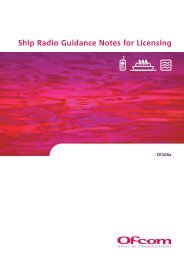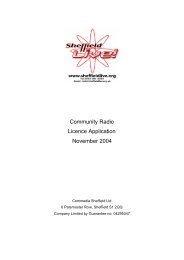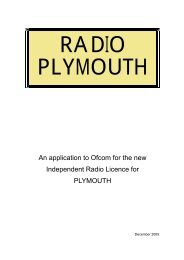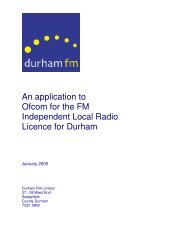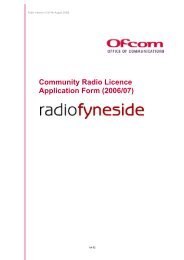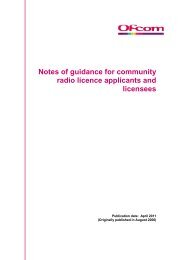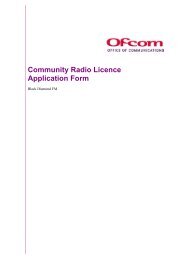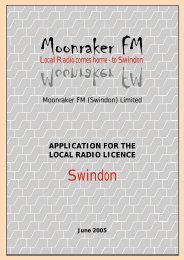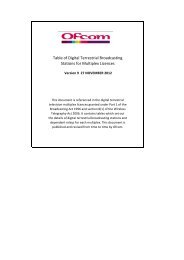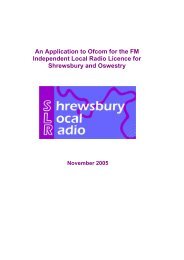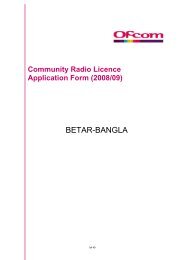Create successful ePaper yourself
Turn your PDF publications into a flip-book with our unique Google optimized e-Paper software.
2. Financial and business plan<br />
(a) Overall Financial Strategy<br />
Section 105 (A): Ability to maintain proposed service<br />
Provide a concise summary of how the applicant considers it is able to establish and maintain,<br />
throughout the licence period, its proposed service, and how this licence fits in with the investors’<br />
strategy.<br />
<strong>Rother</strong> <strong>FM</strong> is part of the Lincs <strong>FM</strong> Group, which has the proven ability to operate successful,<br />
locally-focused radio stations within the competitive Yorkshire marketplace. The Lincs <strong>FM</strong><br />
Group has built its business on its commitment to distinctive and high-quality local radio, and<br />
on its strategy of expanding organically by applying for new radio licences in areas that make<br />
commercial sense to the Group as a whole. Formed in 1991, Lincs <strong>FM</strong> won both the first<br />
(Lincoln) and the last (Barnsley) competitively awarded Radio Authority licences. Lincs <strong>FM</strong><br />
102.2 launched in March 1992 as the new commercial radio station for Lincolnshire, and has<br />
long sustained some of the country’s best RAJAR figures as well as twice being nominated as<br />
Sony Station of the Year. Since then the Group has won seven more local radio licences and<br />
launched seven successful services in Yorkshire and the Midlands. All have won or been<br />
nominated for major industry awards.<br />
The <strong>Rother</strong>ham licence is a perfect fit with our strategy. The borough borders Bassetlaw in<br />
North Nottinghamshire, and Barnsley and Doncaster, both in South Yorkshire: three areas in<br />
which the Lincs <strong>FM</strong> Group has already established successful commercial local radio<br />
stations.<br />
<strong>Rother</strong>ham is the kind of marketplace we understand, not just from a sales point of view but<br />
also in terms of programming and marketing. The borough has, in common with both<br />
Barnsley and Doncaster, gone through some very tough times since the 1980s. While<br />
Barnsley and Doncaster have suffered from the collapse of the mining industry, <strong>Rother</strong>ham<br />
was even harder hit – as the steel industry went into decline as well. Nearly 50,000<br />
<strong>Rother</strong>ham jobs were lost in a 25 year period from around 1970 – 22,000 in steel and 26,000<br />
in coal. Like Doncaster and Barnsley, <strong>Rother</strong>ham is now benefiting from the Objective One<br />
funding status given to South Yorkshire at the beginning of this century, with £1.8 billion being<br />
spent across the region on development projects.<br />
However, while <strong>Rother</strong>ham does have much in common with both Doncaster and Barnsley –<br />
particularly Barnsley, because of its size – we are also very aware of <strong>Rother</strong>ham’s distinct<br />
character and challenges. It has closer ties to Sheffield than either Barnsley or Doncaster, a<br />
result of both geography and the heritage of the steel industry. 40% of <strong>Rother</strong>ham’s<br />
population travels outside the borough to work, 22% into Sheffield. The closeness of this<br />
giant neighbour means <strong>Rother</strong>ham has to fight harder to benefit from the new European<br />
funding. The council has highlighted in particular the fear of “retail leakage” – local people<br />
travelling outside the borough to shop. As a result, <strong>Rother</strong>ham now has an ambitious new<br />
retail development at Parkgate and £3 million has been spent on redeveloping the Centenary<br />
Market in the town centre.<br />
10



